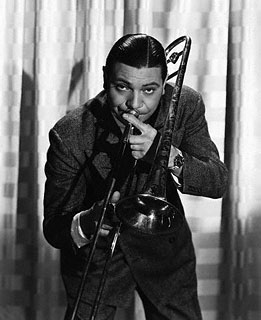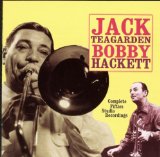Today, August 20, is Jack Teagarden’s birthday. In honor of that anniversary, I’m reposting a bullet-point version of Jack Tegarden’s career. I wrote this some time ago, although I’ve revised it since. Sure, there’s a wikipedia article, but why read that when you can get the information directly from one of the world’s foremost authorities on the subject?

- Originally named Weldon Leo, Jack Teagarden was born in Vernon, Texas, on August 20, 1905.
- Teagarden began studying music early in life. First came piano, then peckhorn. (The peckhorn looks like a small baritone horn, pitched in Eb rather than Bb.) Jack took up the trombone at the age of eight, and was reportedly proficient by the time he was eleven.
- The Teagarden family household was a musical one, mostly because of the influence of Jack’s mother, although Jack’s father did play (apparently weak) cornet in the town band. As the family grew, each of Jack’s new siblings took up a different instrument: Younger brother Charlie played trumpet, sister Norma became a pianist, and the youngest brother, “Cubby,” played the drums.

- Jack had perfect pitch and could, as sister Norma remembered, “Call off the overtones in a thunderclap.”
- Jack discovered his own way of playing trombone, making use of a flexible embouchure and alternate positions to get around the inherent clumsiness of the trombone slide. This general way of “getting around the horn” influenced many contemporaries of Jack, as well as future jazz trombonists such as Carl Fontana. The trombone sound Jack began to develop has often been described as a “jug tone,” slightly nasal and hoarse.
- While still a teenager, Jack began gigging around the Southwest with “barnstorming” bands, including Doc Ross’s “Jazz Bandits” and a band run by the famous but reclusive pianist Peck Kelley. Still unrecorded, Jack arrived in New York in 1927 with Doc Ross.
- While with Kelley, Jack created a way of playing the slide alone with a water glass in place of the bell. The technique, which changed all the usual slide positions, created a muted and earthy sound that Teagarden used expressively on a variety of tunes, especially the blues. One of the best examples of this amazing slide-with-glass playing is St. James Infirmary, from a 1947 concert recorded at New York City’s Town Hall.

- Jack became known as a masterful blues trombonist, and by his own account he became familiar with the sound of “blue notes” by listening to the African American holy-roller-tent-revival meetings that took place near his childhood home in Vernon.
- Louis Armstrong became a musical hero early on when Jack discovered the trumpeter’s records. Supposedly, Jack and trumpeter Wingy Manone buried a copy of Armstrong’s Oriental Strut in the Southwestern desert, hoping the record would become petrified for the benefit of future generations. Later, Teagarden would go on to perform with Armstrong many times.
- Jack first recorded with Louis Armstrong in 1929 — one of the earliest racially mixed sessions. The tune was a blues, Knockin’ a Jug.
- In 1944, Jack, with the help of his band, provided the soundtrack for two Walter Lantz Universal Cartoons: The Pied Piper of Basin Street and the Sliphorn King of Polaroo.
- Jack eventually recorded and performed with most of the major jazz musicians of his time, which kept him on the road throughout his life.
- Jack played with the following groups, among numerous others:
- Ben Pollack, 1928-1932.
- Paul Whiteman, 1933-1938.
- Various editions of his own — sadly, mostly mis-managed and perpetually in-debt — big band, 1939-1946.
- The Louis Armstrong All-Stars, 1947-1951.
- His own small quasi-dixieland groups, one of which did a tour for the U.S. State Department in 1958.
- Jack’s singing was just as beguiling as his trombone playing to many. Like his trombone sound, his voice had a distinctive timbre, “Between croon and moan,” as critic Nat Hentoff described it.
- Teagarden enjoyed tinkering with mechanical things. He designed mutes and mouthpieces, occasionally taking a lathe on the road with him. He owned and worked on two Stanley Steamers during his life, although one was stolen when he let a prospective buyer take it for a test drive.
- Teagarden supposedly originated the use of Ponds cold cream as a lubricant on trombone slides.
